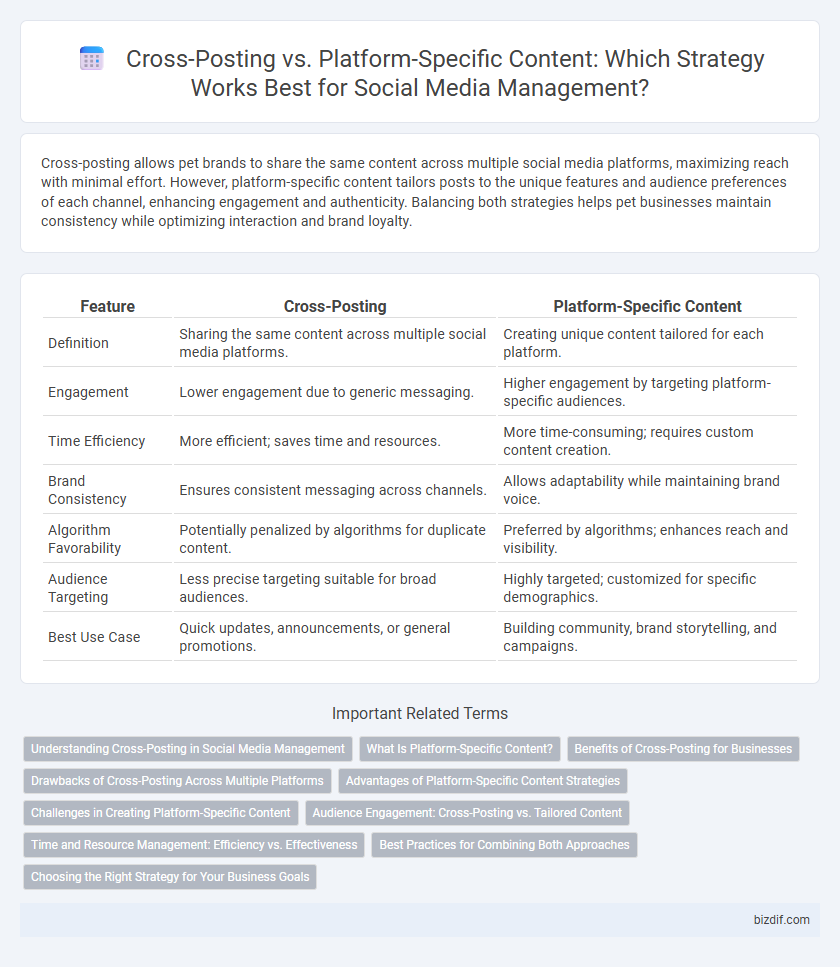Cross-posting allows pet brands to share the same content across multiple social media platforms, maximizing reach with minimal effort. However, platform-specific content tailors posts to the unique features and audience preferences of each channel, enhancing engagement and authenticity. Balancing both strategies helps pet businesses maintain consistency while optimizing interaction and brand loyalty.
Table of Comparison
| Feature | Cross-Posting | Platform-Specific Content |
|---|---|---|
| Definition | Sharing the same content across multiple social media platforms. | Creating unique content tailored for each platform. |
| Engagement | Lower engagement due to generic messaging. | Higher engagement by targeting platform-specific audiences. |
| Time Efficiency | More efficient; saves time and resources. | More time-consuming; requires custom content creation. |
| Brand Consistency | Ensures consistent messaging across channels. | Allows adaptability while maintaining brand voice. |
| Algorithm Favorability | Potentially penalized by algorithms for duplicate content. | Preferred by algorithms; enhances reach and visibility. |
| Audience Targeting | Less precise targeting suitable for broad audiences. | Highly targeted; customized for specific demographics. |
| Best Use Case | Quick updates, announcements, or general promotions. | Building community, brand storytelling, and campaigns. |
Understanding Cross-Posting in Social Media Management
Cross-posting in social media management involves sharing the same content across multiple platforms to maximize reach and maintain brand consistency. This strategy saves time and resources but may reduce engagement if content does not align with each platform's unique audience preferences and algorithms. Effective cross-posting requires tailoring captions, hashtags, and posting schedules to optimize visibility and user interaction on each social network.
What Is Platform-Specific Content?
Platform-specific content is tailored to the unique features, audience preferences, and algorithms of each social media channel, enhancing engagement and reach. This type of content considers platform nuances such as Instagram's emphasis on visuals, Twitter's brevity, or LinkedIn's professional tone to optimize user interaction. Creating platform-specific content improves brand authenticity and drives more meaningful connections compared to generic cross-posting.
Benefits of Cross-Posting for Businesses
Cross-posting enables businesses to maximize content reach by sharing the same post across multiple social media platforms, increasing audience engagement without creating new content for each channel. This strategy saves time and resources while maintaining brand consistency, allowing companies to allocate efforts toward other marketing initiatives. Leveraging cross-posting helps businesses amplify their message, enhance visibility, and drive traffic across diverse digital audiences efficiently.
Drawbacks of Cross-Posting Across Multiple Platforms
Cross-posting across multiple social media platforms can lead to reduced engagement due to content not being tailored to the unique audience preferences and algorithms of each platform. This strategy often results in generic posts that fail to maximize reach or interaction on sites like Instagram, Twitter, and LinkedIn. Brand voice inconsistencies and missed opportunities for platform-specific features further diminish the effectiveness of cross-posting compared to creating customized content.
Advantages of Platform-Specific Content Strategies
Platform-specific content strategies boost audience engagement by tailoring messages to the unique features and user behaviors of each social media channel, such as Instagram's visual storytelling or LinkedIn's professional tone. Customized content increases relevance and interaction rates, driving higher conversion and brand loyalty compared to generic cross-posting. Brands can leverage platform algorithms more effectively by optimizing content formats, timing, and messaging to match each platform's ecosystem.
Challenges in Creating Platform-Specific Content
Creating platform-specific content involves challenges such as understanding the unique algorithms and audience behaviors of each social media platform, which can significantly increase the time and resources required for content creation. Brands must tailor visuals, captions, and posting schedules to fit the preferences of users on each platform, complicating content strategy and execution. Balancing consistency in brand voice while optimizing for platform-specific engagement metrics demands careful planning and skilled social media management.
Audience Engagement: Cross-Posting vs. Tailored Content
Cross-posting shares identical content across multiple social media platforms, simplifying the process but often resulting in lower audience engagement due to platform-specific preferences. Tailored content, crafted to fit each platform's unique format and user behavior, drives higher interaction rates and strengthens audience connection. Brands focusing on engagement metrics like likes, comments, and shares benefit from investing in customized content strategies tailored to each social channel.
Time and Resource Management: Efficiency vs. Effectiveness
Cross-posting saves time and resources by distributing identical content across multiple social media platforms, streamlining management efforts. Platform-specific content requires more investment in time and resources but enhances effectiveness by catering to the unique audience preferences and algorithms of each channel. Balancing efficiency and effectiveness is essential for optimizing social media strategies and maximizing engagement and reach.
Best Practices for Combining Both Approaches
Effective social media management involves leveraging both cross-posting and platform-specific content to maximize reach and engagement. Cross-posting saves time by sharing core messages across multiple channels, but tailoring content to each platform's unique audience and format enhances relevance and interaction. Implementing a strategic mix--such as repurposing key themes while customizing captions, hashtags, and media--ensures consistent branding alongside optimized user experience on Instagram, Facebook, Twitter, and LinkedIn.
Choosing the Right Strategy for Your Business Goals
Choosing the right social media strategy depends on your business goals and target audience engagement. Cross-posting saves time by sharing identical content across multiple platforms, boosting brand consistency but may reduce platform-specific engagement. Creating platform-specific content maximizes relevance and user interaction by tailoring posts to each channel's unique features and audience preferences.
Cross-posting vs Platform-specific content Infographic

 bizdif.com
bizdif.com